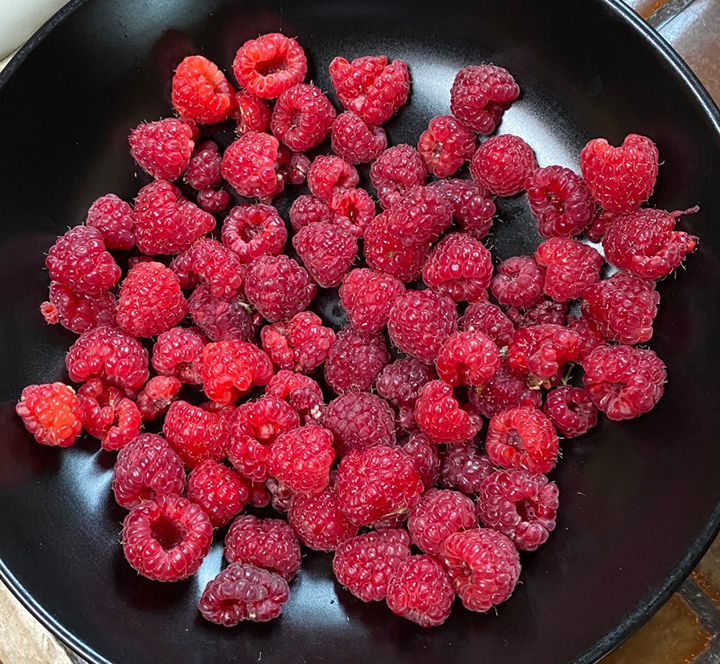Here are some pics of recent harvests. Many crops have been harvested and quite a few are still ready to harvest. As the season winds down, and crops finish, I turn off the drips to each bed with annual crops. There are still a few tomatoes, 25 Butternut squash will be harvested the day before our first freeze next tuesday, potatoes need to be dug out, onions done and curing, chard and kale still kicking, cucumbers done, dry beans picked, green beans done, peppers still going, zucchini pretty much done, a huge load of apples to still be picked, raspberries and grapes are almost done and blackberries done and most of the flowers have faded throughout the garden. Things are winding up pretty fast here.
This year’s Kale

Scotch curly kale
Kale (and chard) are loving the cooler weather while the warm season crops are fading. I grew two kinds of kale this year. The first one is Scotch Curly Kale shown above which has done really well. No aphids or cabbage looper damage (from the cabbage moth). A super producer!

Cabbage looper damage on Lacinato kale
The other kale which is my favorite, is Lacinato kale. It is also known as Tuscan kale, Italian kale, dinosaur kale, black kale. It has struggled with attacks from cabbage moths which resulted in very ‘holey’ kale from the cabbage moth looper. I don’t know why they attacked the Lacinato but not the curly kale but I left them in as a trap crop to attract the cabbage looper to them. I could of sprayed Bt, an organic caterpillar insecticide but didn’t get to it. The crops were not close to each other.

Top leaves of Lacinato recovering from damage
Today I noticed that the new leaves on the Lacinto are perfect-no holes so I think the cabbage moth is gone. So I trimmed off all the holey leaves on the bottom and gave them to my chickens and will harvest the nice leaves soon. The chickens love it.
I will leave all the kales in the garden for now as they love the cooler weather and will cover them with row cover when the first freeze comes next week (WEATHER FREEZE FORECAST TUESDAY OCT 12!).
I have to confess I never have liked kale finding it too tough for me. But I do really like it in stews and soups where it softens up. To prepare it to use later, I trim off all the leaves from the stalks, rough chop it and steam the kale for 2 minutes. I super cool it quickly under water with ice to stop the cooking. I then drain and squeeze out all the liquid and put it in 2 cup increments in freezer ziplock baggies and freeze it. It’s the perfect amount to put into stews and soups in the winter.
Garden starting to wind down
I noticed this week, the garden is starting to wind down except for the tomatoes which are still kicking ass.
The raspberries, grapes and blackberries will continue being harvested this month as well.
The potato leaves are starting to yellow which is a sign that once they (almost) die, they will be ready to harvest. I’m thinking 2-3 more weeks before they are ready.
The green beans are basically done and the dry beans leaves are yellowing and the pods are starting to dry out on the vines. Once they are dry, I will pick them all and store them until winter when I will shell the dry beans inside on a winter nite. Too busy right now with harvesting tomatoes!
The poblanos, Jimmy Nardello, Espellette and Lava Red peppers are continuing to ripen and I’m harvesting them as they ripen. The cucumbers are starting to slow down.
The Butternut winter squash are starting to turn color to their tan color but will be several more weeks. The summer squash harvest is bonkers. Looking for victims and new ways to use them!
The onions can get a little bigger before harvesting.
The cauliflowers an beets are harvested, while the kale and chards are loving the cool weather.
My garlic and shallots that were planted last October were harvested in June.
Cauliflower this year

I started cauliflower for the first time in late spring, and have been harvesting it since late July through August (and even now). This orange variety above (4.5 lbs) is called Cheddar because of it’s color (but does not taste like cheese.) I also grew a white variety (Freedom). I have only one left to harvest. Really outstanding flavor with both varieties. Easy to grow but did get a few cabbage loopers later in the season.
This is an easy fix-to get rid of cabbage looper caterpillars, either spray in the season with Bt, an insecticide that kills only caterpillars. Does not affect other insects, pets, birds or bees. Another thing you can do is soak the cauliflower head (I actually break it up into bigger pieces in salt water for about 10 minutes and the loopers float off.
HORNWORMS!

I have lots to share so I will be writing a lot in the next few days. I was on vacation for 7 days and am now back and busy harvesting and weeding. The first day back, I saw one of my Black Cherry tomato plants was overwhelmed by tomato hornworms. As you can see in the pic above, they ate all the leaves on the top 1/3 of the plant. Interesting that they seem to like that variety but I only found 2 more on that tomato bed that has 9 tomato plants-all right next to each other. I can see why the hornworm would like the Black Cherry tomato as it is one of my favorites too! On all the other 29 tomato plants, I only found a couple of hornworms. We handpick the hornworms off wearing gloves because I’m squeamish about them.

So I think we got around 100 hornworms in all different sizes on that one plant. Never had so many hornworms on one plant. Found and picked most of them off that day.

Then went back at night with my UV flashight and found about 50 more. The hornworms glow under UV light making them easier to find-this helps find smaller ones too that I missed in the day. I got mine on Amazon. So keep a lookout for hornworms-they are around now!
Lots of rain=fungal diseases
With all that blessed rain comes new problems for veggie gardeners-mainly fungal diseases are on the rise.
WOW! This has been a great monsoon season this year. Last year we had 2 tiny monsoon storms and then they disappeared and we went into an extreme drought. This year, we have gotten more rain than I can remember in many years. Every week we get a significant amount of rain and 2 weeks ago we got 2.5 inches of rain in 1.5 hours. It was torrential. Those of us on the southeast side of Santa Fe have gotten most of the rain while those on the west side of town haven’t gotten much.

TOMATOES-EARLY BLIGHT: I already trimmed the tomato plants so no leaves touch the ground, put straw around each plant so no dirt is showing, but I still have started to see Early Blight (EB) on a few of the tomato plants. Early Blight fungal spores live in the ground and when rain splashes the dirt up on the lower leaves, the fungal spores start to colonize on the lower underside of the leaves. They become blotchy with the lower leaves getting big yellow splotchy areas. This is Early Blight. Without doing anything, it will spread upwards and go up through the plant and eventually kill it. But we can control it. I use to use Serenade, a biological fungicide that has other micro-organisms that colonize on those leaves and crowds out the EB spores. But now we can’t get Serenade anymore. I don’t know why but can’t find it anywhere. So I’ve turned to 2 other products. One is called Cease, which has the same ingredients as Serenade but is way more expensive and the other is Copper Fungicide which has copper in it which helps suppress the EB disease but you shouldn’t spray the soil as it can affect the earthworms-keep it on the foliage.
The way to control it is: trim off all lower branches that show signs of EB. Be sure to dip your cutters in a solution of 10% bleach to water. I just put a little in a small container of water and dip the shears and your hand into it BEFORE moving to the next plant. EB is contagious between plants so disinfecting your cutters between plants will make sure you don’t spread it.

SQUASH-POWDERY MILDEW: Another fungal disease on squash and pumpkin plants is Powdery Mildew. If your leaves start to die and get a powder on them, you should spray them on top and underside of leaves with a fungicide. Again copper fungicide, Neem, Baking soda/water mix, GreenCure. My favorite IS Green Cure as it works pretty fast. Spray any of the affected plants at 2-3 times with any o the above to get rid of it.
OTHER PROBLEMS

TOMATO-BLOSSOM END ROT: There are other problems arising from too much rain (is that possible out here in the southwest?!) Tomato blossom rot is from too much water, or uneven watering or not enough calcium in the soil (leached out because of too much rain). It is not a fungal disease but rather a deficiency of calcium in the tomato. It appears on the bottom of the tomato and is a sunken brown lesion. You can cut it out and eat the rest of the tomato if the whole fruit is not impacted.
Keeping the soil evenly moist helps. If we get a big rain, turn off your drip system for a day or two. You can also do a foliar spray on the plants with a kelp (seaweed) solution. But usually it will correct itself thru time. Adding calcium in the form of bone meal, oyster shell powder or gypsum — to the soil when you plant usually helps prevent this problem from developing.
First raspberries of the season!

First small harvest of raspberries was yesterday, July 25. It seems early this year as this variety, called Polana, is usually a fall bearing raspberry, not mid summer. Hopefully we have a long raspberry season this year. Ate them with vanilla ice cream-yummy! Last year, I started harvesting blackberries before raspberries but not this year. One good thing is all the berries are getting lots of water from our monsoons this year. Blessed be.
Hypertufa Planter Workshop and Demo this Sunday

NEXT HOME GROWN NEW MEXICO EVENT: This Sunday is going to be exciting to learn how to make these unique planters at this outdoor event. Not too late to sign up! I’ll be there!
Sunday, July 18, 2021
12 noon to 2 pm
Hypertufa Planter Workshop & Demo
Get ready for planting with these easy to make and durable plant pots that will look great in your garden and last for years. These rock-like pots are wonderful for displaying rock-garden plants. They look like stone, but weigh less and can take whatever shape you want.
Instructor: Bob Zimmerman and Chris Salem
Location: 56 Coyote Crossing • Santa Fe
Fee: $5 for members/$20 for non-members
____________________________________________
Monsoons are here-Row covers come off tomatoes over weekend!

Well, we’ve had lots of showers over the past week and more predicted. The weather people say the monsoons are here with the rain and cooler temps. So, I will be taking the row covers off my tomato plants which has been protecting the tomato plants from the beet leafhopper for the last month. (You may recall, the leafhopper can bite the tomato plants and give them a virus which is deadly to our tomato plants). With all the moisture and more forecasted, I believe the leafhopper is gone so off come the row covers this weekend. Finally I will be able to enjoy watching the tomatoes grow!
the last month. (You may recall, the leafhopper can bite the tomato plants and give them a virus which is deadly to our tomato plants). With all the moisture and more forecasted, I believe the leafhopper is gone so off come the row covers this weekend. Finally I will be able to enjoy watching the tomatoes grow!
When I open them up, I will pinch off any suckers, pull any weeds beneath them and put straw under the plants for to protect them from soil-borne fungal spores from bouncing up on the lower leaves and starting a disease like Early Blight. If some suckers have flowers, I will let those stay-Remember more blossoms mean more tomatoes!
The reason I pinch off SOME suckers is to provide more air flow to the tomato plant as crowded plants are more susceptible to fungal diseases. Once I feel they are opened up, I will let suckers remain as they will produce blossoms at some point. Can’t wait to see the girls!
Now we just have to be careful to protect all our veggies from any possible hail storms!
Hurray! The monsoons are here!
Butternut winter squash
Here is a winter squash I really like-Butternut squash. I’ve mentioned it before but it’s worth repeating.
Butternut squash doesn’t usually attract squash bugs. I’ve grown the very sweet Waltham Butternut, an Italian variety called Rogosa Violina and a huge variety called Tahitian Butternut-all don’t seem to attract squash bugs, at least in my garden and all have the wonderful flavor we associate with butternut squash.
It also doesn’t attract squash vine borers. The stems are solid and the squash vine borer like to lay it’s eggs in hollow stem varieties of both winter and summer squash. 100 days to harvest so if you plant right now, you may get to harvest as it will be ready right at the end of our season.
Friulana summer squash-a big winner!
 It’s not too late to plant zucchini or summer squash as you will still get lots this season. I’m totally smitten with Rugosa Friulana summer squash. I’ve written about it before but feel its worth mentioning again.
It’s not too late to plant zucchini or summer squash as you will still get lots this season. I’m totally smitten with Rugosa Friulana summer squash. I’ve written about it before but feel its worth mentioning again.
You can get seeds from Seeds from Italy. It takes 40-60 days to harvest so there is still plenty of time to grow from seed. If you let it get large, it will be ‘woody’ and is better harvested small from 6-7 inches.
Two reasons I really like this summer squash. First, it has a wonderful sweet, nutty taste with dense flesh and doesn’t get ‘watery’ when cooked down. Second, it doesn’t attract squash bugs in my garden. I can’t say this for every garden but everyone I give it too has had the same experience. I don’t know why they don’t mention it in the description, but that is a really another big reason for me to grow it. Anything to make my work easier in the veggie garden is good. I don’t know about squash vine borers as I always keep all squash covered early in the season with row cover when the squash vine borers are out and about. I take it off when the blossoms appear. Try it-I think you will be come a big fan of it too.
PS: Some of you have mentioned that your Friulana summer squash did attract squash bugs so I can’t make a definite statement that it won’t attract them because in some gardens it evidently does. But I do feel that I have less problems with this variety regarding squash bugs but appreciate your imput regarding this variety.
Monsoons coming early?
 It’s getting cooler this coming week and it looks like we MIGHT be starting the monsoons early (that will be a first!) BUT I’m not taking the row covers off the tomato plants just yet. I want the monsoon pattern to really set up-not just a few scattered showers.
It’s getting cooler this coming week and it looks like we MIGHT be starting the monsoons early (that will be a first!) BUT I’m not taking the row covers off the tomato plants just yet. I want the monsoon pattern to really set up-not just a few scattered showers.
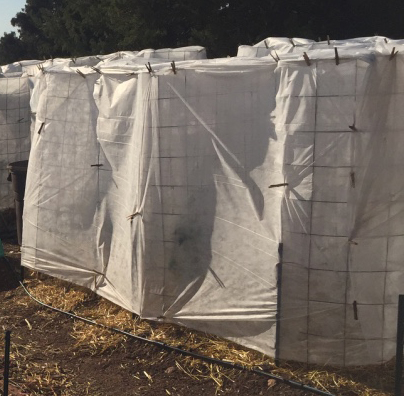 I will post here on this blog when I do take them off. You could be a gambler and take them off early but I figure I’ve waited this long and don’t want to chance it. I can hardly wait to take them off but must have patience!
I will post here on this blog when I do take them off. You could be a gambler and take them off early but I figure I’ve waited this long and don’t want to chance it. I can hardly wait to take them off but must have patience!
Heat is brutal on veggie garden

Except for last night, the heat has been brutal. Last nite was actually chilly but it is going to be hot again the rest of the week. The temps have been in mid-high 90’s and with the unrelenting wind and UV factor due to our elevation, I’ve found I needed to cover everything in the veggie garden as the newly transplanted starts were not happy.
I planted my peppers and left them uncovered for half an hour and when I came back, some of the leaves fried and died. I had to immediately add protection in the way of row cover to add a little shade. Same with winter squash, except it only took 5 minutes in the sun before the leaves started dying. So I immediately covered them with row cover and also added some shade cloth for a few days till they adjusted. They all need more water too. As the weather gets cooler, we can remove the rest of the row cover.

However the tomatoes which I planted on May 11th, are cozy in their cages wrapped with row cover (as seen above) as we need to keep a physical barrier between the dreaded beet leafhopper and the tomato plants. The leafhopper bites the plants and gives them a deadly virus. We should be able to remove the row covers off the tomato cages once the monsoons come the leafhopper disappears.
 Hard to grow anything in our sometimes harsh environment and isn’t getting any easier with our global warming. The temps are getting hotter again this week but in the low 90’s. I’ve found the end of June thru the first week of July is usually the hottest part of the year here in Santa Fe. Then the monsoons are suppose to come and give us moisture and cooler temps.
Hard to grow anything in our sometimes harsh environment and isn’t getting any easier with our global warming. The temps are getting hotter again this week but in the low 90’s. I’ve found the end of June thru the first week of July is usually the hottest part of the year here in Santa Fe. Then the monsoons are suppose to come and give us moisture and cooler temps.
Last year, we only got 2 monsoon storms in July and then NO RAIN the rest of the season. I was forced to water more without the monsoons. We’ve been in an EXTREME drought the rest of the year. With help from the universe, we will hopefully get a monsoon season this year.
Pepper time!
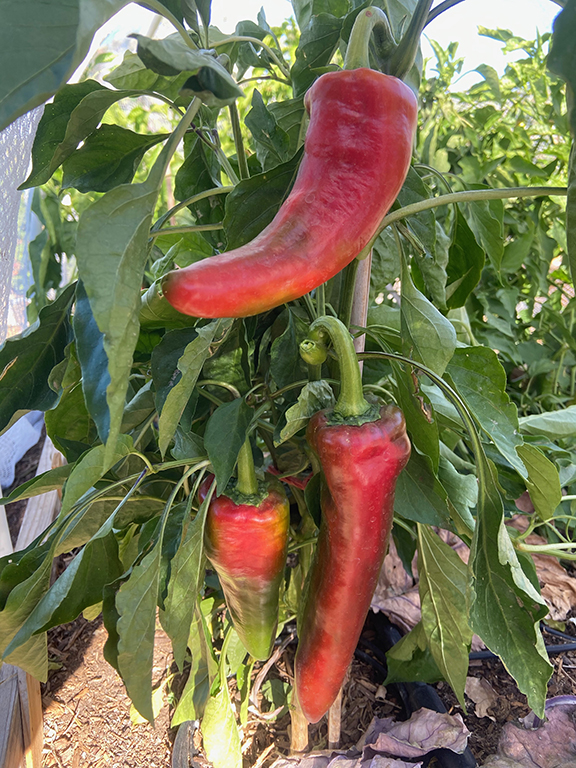
Lava Red Italian pepper became a favorite of mine last year. It is a variety of Corno di Horno red pepper-sweet. This one came from a friend (named Lava) who gave me some seeds from a German Farmers Market and she didn’t know the exact variety so I named it after her. You can find other Corno di Horno varieties at nurseries.
I know many of us have been waiting to put peppers out in their gardens, well wait no longer! I usually wait till June 1 to put them because I wait till the day temps are in the 70’s and the NITE temps are in the mid 40’s. When I look at the 10 day forecast today, we are there.
 I plant my peppers in wall of waters-WOWs. (yes, just like I plant my tomatoes) because even in the mid 40’s, it is still very cool for a pepper at nite. This will reduce transplant shock and warm the interior of the WOW’s to help keep the peppers warm at nite. Peppers HATE being cold and if planted too early without protection, they might stall out. By that I mean they just stop growing and nothing will kick start them again-they will just sit there and nothing happens. I learned the hard way and have had to go buy more pepper plants when I first started growing peppers and planted too early. When I plant in WOWs now, I never have that problem anymore. I always plant them on a sunny day in the morning so the WOWs can heat up. I will keep them in the WOWs until it gets stinking hot here sometime in June-then I take the WOWs off as they usually don’t reach the top of the WOW. Wall of Waters are used as a spring aid but don’t keep your peppers or tomatoes in them all season. They also help us by providing wind protection too in the spring, which has been bad this year. Wind can really beat up any tender seedling-another good reason to use WOWs.
I plant my peppers in wall of waters-WOWs. (yes, just like I plant my tomatoes) because even in the mid 40’s, it is still very cool for a pepper at nite. This will reduce transplant shock and warm the interior of the WOW’s to help keep the peppers warm at nite. Peppers HATE being cold and if planted too early without protection, they might stall out. By that I mean they just stop growing and nothing will kick start them again-they will just sit there and nothing happens. I learned the hard way and have had to go buy more pepper plants when I first started growing peppers and planted too early. When I plant in WOWs now, I never have that problem anymore. I always plant them on a sunny day in the morning so the WOWs can heat up. I will keep them in the WOWs until it gets stinking hot here sometime in June-then I take the WOWs off as they usually don’t reach the top of the WOW. Wall of Waters are used as a spring aid but don’t keep your peppers or tomatoes in them all season. They also help us by providing wind protection too in the spring, which has been bad this year. Wind can really beat up any tender seedling-another good reason to use WOWs.
You can get them or a me-to one at Agua Fria Nursery here in town or at Amazon. So put them in now but give them the protection they need from the wind and the cold nites for best results.
Lettuce begin or end?
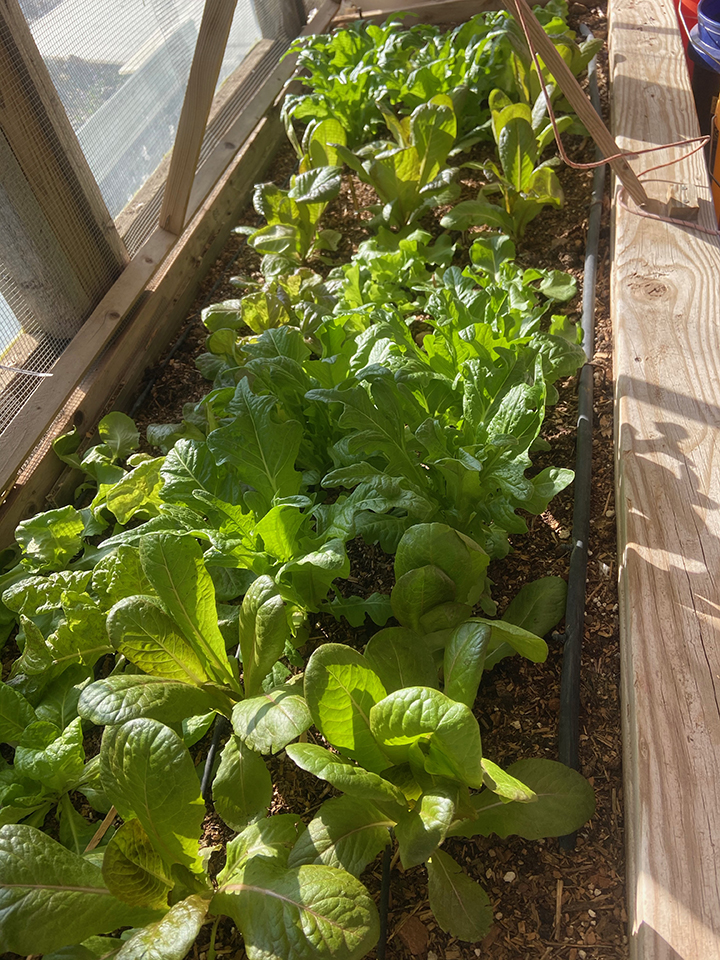
Cool season lettuces in green house May 6, 2021
Some of you are just beginning to grow lettuce and for some people you will be ending growing this delicious cool season crop. This year I grew in my greenhouse Cimarron romaine, Santoro butterhead, Bunte Forellenschluss, Yugoslavian Red butterhead and Italienischer oakleaf. I also grow Salanova lettuce which the mice are enjoying. (Trying to keep them out). These all do well while it is cool in spring but when it gets hot, they will bolt. I started them inside, under lights, no heat back in the end of February and yesterday it almost got to 90°F inside-way to hot for them. I’ve been harvesting them since late March and have had 4 harvests. I just harvested today (probably my last due to upcoming heat). I only put row cover on them during a predicted freeze for protection now that it appears freezing nites are over.

Lettuce bolting
What is bolting? It’s where the plant puts up a tall stalk in the center and starts to flower which is called bolting. Bolting is ok if you plan to save the seeds but if you want to eat it, pick lettuce before it bolts as the lettuce will get bitter. If you wait too long, you can compost it or if you have some chickens, feed it to them as they still love it even though it is too bitter for most people. If it has flowers, you’ve waited too long.

Harvest outer leaves and let grow back
To harvest, I take the lower outer leaves and leave the center (where they produce the leaves) intact. That way they can grow back for more harvests. The other way to harvest is cut off the whole head off which I might do when I think they are going to bolt.
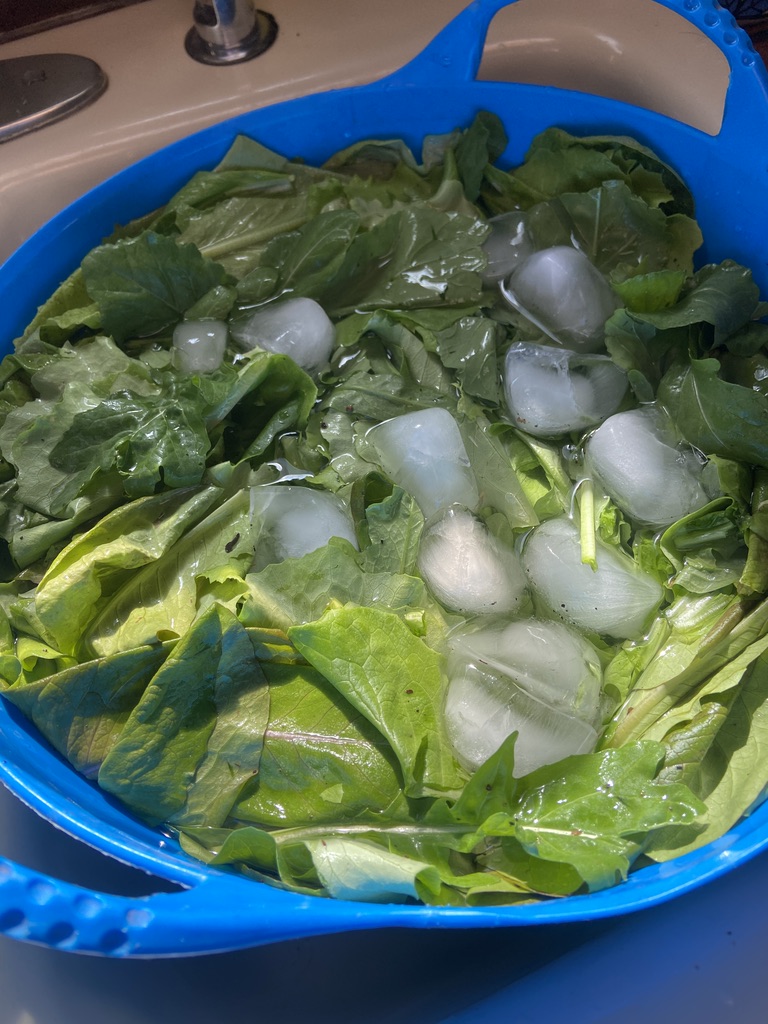
Then I take it and put cold tap water in the container with your freshly harvested lettuce and add a few ice cubes to get the water really cold and it will perk up and suck up a lot of the water.

I after rinsing it to clean and draining it, I put it in plastic baggies loosely-don’t stuff it tight and I like to wet a paper towel with cold water, fold it over several times till it makes a small square, squeeze out the excess water and put it in the bag that you’ve closed up tight and in the crisper-it lasts much longer. The night before I want to harvest, I water the lettuce well and I harvest it EARLY in the morning the next day before the heat sets in. Never harvest when it is hot or it will be wilted and you will be disappointed. All of this applies to spinach and arugula as well.
If you’ve already planted lettuce or are just starting outside from seed, you should put row cover right on top of it to provide shade and keep out rodents, which also love it. Row cover at night will also add protection from any late freezes we get. I use a medium weight row cover (also called Agribon) about .5 mil in thickness with 85% light transmission. No winter weight row cover (.9 to 1.2mil) now which would not provide enough light and would hold in too much heat for the plants. You want rain (HA!) and air to get thru it and you can water right thru it too. To keep rodents out, I lay 2×4 boards all around the edges of the row cover to secure it from wind and rodents. And definitely plant in a shady part of your garden now for sure or make your own shade as mentioned above.
So is lettuce season coming to an end yet? Well, yes and no. The cool season lettuces will definitely be finishing up soon as it gets hotter but there are varieties of SUMMER LETTUCE that you can plant that will resist bolting if grown under shade. These are called Batavian or Summer Crisp lettuces. Look these up on the internet for varieties you can buy and where. I will write about them and how they do here in the summer and what varieties I have tried in the next post. Stayed tuned…
